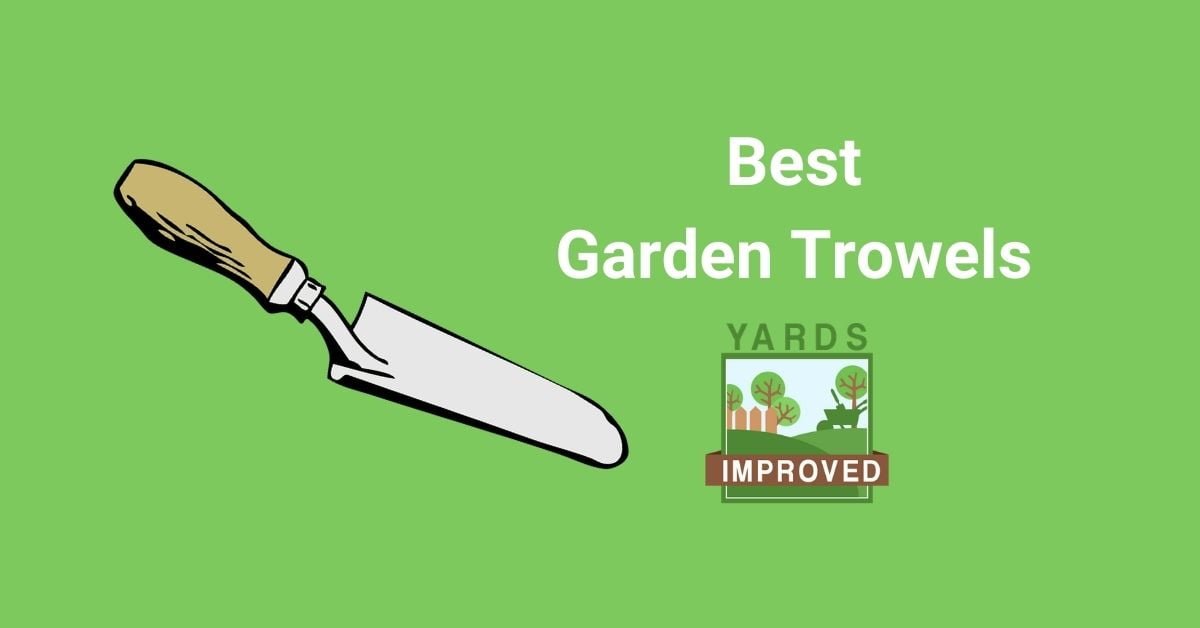Working in your garden means that you’ll have the chance to work up close with the earth. And of course, you’ll have to dig the small holes for your seeds, bulbs, and plants that a shovel or spade is too large for. A trowel is the right tool for the job, but you need to be sure to get one that’s durable and easy to use. So what are your options?
What Is A Trowel?
Let’s start ,by defining what exactly a trowel is. Of course, we’re not talking about masonry trowels here. A garden trowel looks like a tiny shovel. It has a small handle and a curved blade for digging and scooping soil. The handle is sized for one hand.
This makes it an ideal tool for digging small holes. It’s designed for small, up-close, detailed work. When you need a hole that’s just a couple of inches deep and a couple of inches wide, this is the tool of choice. It’s good for planting and transplanting as well as for pulling up weeds right from the roots.
Got a bigger job? Check out the top-rated garden spades.
What To Look For In A Trowel
While a trowel is a simple tool, there are still important things to consider when choosing one.
First, you want to consider the material it’s made of. While there will be plenty of times when you’ll just be digging in light topsoil, there are also times you’ll face tougher digging. Compacted soil that has a high clay content is just one example. You can also unexpectedly hit rocks or roots. And a strong blade on your trowel can even help cut those roots when necessary.
Trowel blades are most often made of steel, aluminum, fiberglass, or plastic. Of course, steel is strongest. That makes it ideal when you know you’ll be digging in rocky soil or need to handle roots. However, steel is also heavy and your hand can quickly become tired when using a trowel made this way. For regular digging in a garden bed, any of the other materials offers a suitable alternative. They are lighter but still sturdy enough to do the job and hold up over time.
The handle is another key part of the trowel. You need one that is easy to hold and that won’t cause soreness or discomfort with repeated use. Many trowels have cushioned handles made of polymer. Some even have ergonomically-designed handles. But even a straight handle can be good enough as long as it fits your hand well.
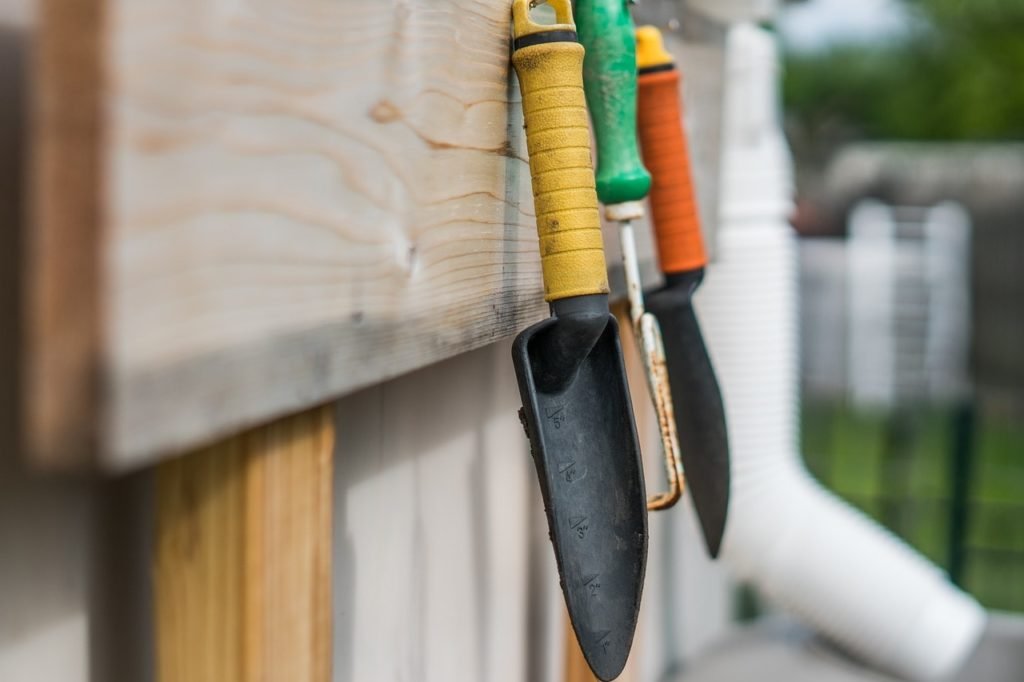
Handle length is important, too. For fine work, such as digging in a flower pot or around seedlings, you will probably prefer a short handle. However, a long handle provides more leverage. That makes it more suitable for digging deeper or prying up rocks and roots.
Of course, the way the blade and the handle are joined together is another important consideration. Avoid trowels where the top of the blade simply slides into the handle. It will just as simply slide out while you’re trying to work! This is known as a “tang and ferrule” blade and is never a good option. Look for a one-piece tool or one that is firmly attached with a rivet or bolt.
Blades come in various widths and lengths. You might find that you want to have a set in various sizes. It depends on the type of hole you need to dig. Too large a blade means a hole that’s not suitable for what you need. But too small can mean extra work digging the hole large enough.
Almost all trowels have a curved blade, which is important for helping to scoop dirty and move it out of the hole. But some are more curved than others. If you do a lot of transplanting of seedlings or need to move a decent amount of soil, you might want to have one that is more scoop-like.
Some trowels have other optional but helpful features as well. For instance, some blades have marks indicating depth so you can know exactly how deep to make the hole. There are also many “specialty trowels” that are suited for particular jobs. The ones we’re talking about are the most general, but you can find all types of blades. There are even “trakes” – a combination trowel and rake!
Best Practices For Using A Trowel Comfortably
Gardening is a great activity, but of course, it can lead to pain if you aren’t careful about how you use your tools.
The first step to using a trowel comfortably is to choose a comfortable trowel. Choose one with a grip that fits well in your hand. Also, choose a lighter one unless you need a heavy-duty tool for the job at hand.
only choose it when it’s the right tool for the job. While it can do many things, it’s designed to be used to dig small holes. It’s fine for chopping small roots or prying small stones. But don’t try going too far here! For bigger holes – or bigger obstacles – you should switch to tools that are more specialized for that use.
Wearing gloves is also important. They will help protect your hand from the friction of the tool rubbing against your skin.
Our Picks For The Best Garden Trowels
Now that we know what to look for, let’s have a look at some of the best garden trowels available. While sometimes it is helpful to get a feel for them in person to see how well they fit your hand, these are highly recommended and work for most people.
Fiskars Big Grip Trowel

This trowel from Fiskars receives high ratings all the way around.
It has a cast aluminum blade with a rather pointy end. The curve is somewhat deep – we wouldn’t quite call it a “scoop” but it’s deeper than many options.
The handle is a little wider than many, which can make it easier for larger hands. It’s made of a “Softgrip” material that’s comfortable, as well.
The entire tool – blade and handle – measures 13 inches from end to end. The blade is about 4 inches wide at its widest point. It weighs about 10.7 ounces, so it’s not too tiring to use it.
If you have smaller hands, this may not be the tool for you. Also, the blade is somewhat thick, even at the end, so it isn’t always easy to penetrate the soil with it.
Garden Guru Super Strong Garden Trowel
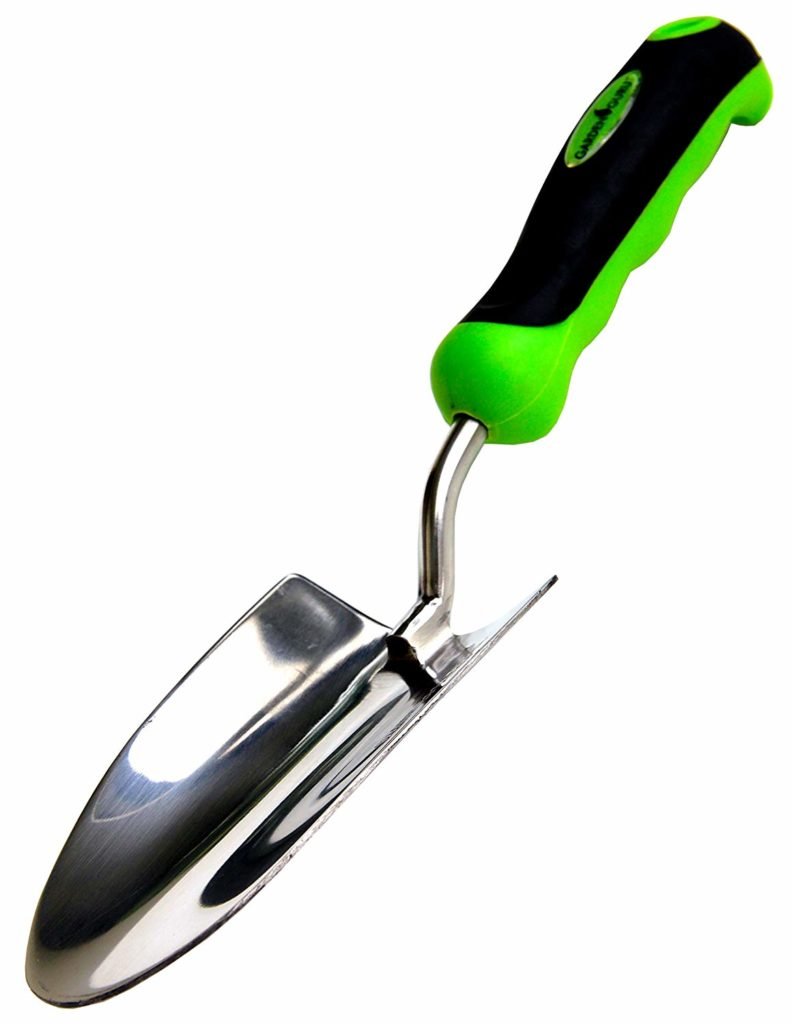
Garden Guru sells this stainless steel trowel that has a nice handle. The total length is 13.2 inches and the widest point of the blade is 5.5”. It weighs just 9 ounces despite being made of steel.
The handle is welded to the blade. While it seems like most users have had no problem with it, a few say it broke at the weld. It seems to be a rare problem and most report that they’ve had no issues at all and that it lives up to the “Super Strong” name. We didn’t see any issues when testing it.
Its handle is somewhat large – not as big as the Fiskars model above, but people with smaller hands may have trouble with it.
Overall, it’s a quality piece that seems to us to be strong enough for regular garden work. It’s also comfortable to hold and lightweight.
Radius Garden 100 Ergonomic Aluminum Hand Trowel
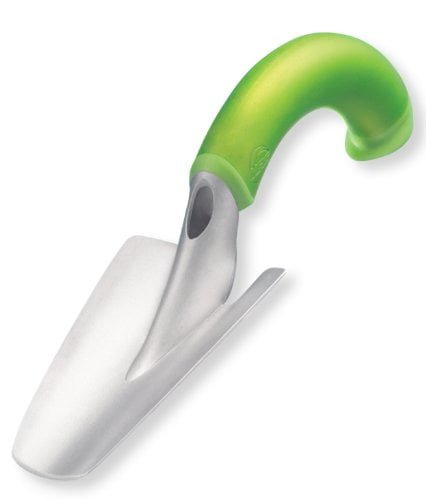
This garden trowel from Radius Garden has the most unique handle we’ve seen. But that doesn’t detract from its quality. While its color and shape may be the first thing you notice, its usefulness will be the reason you want to invest in it.
This trowel has a cast aluminum blade that measures about 3.3 inches wide. With the handle, the whole tool is just under 12” long. It comes in at a very lightweight 7 ounces.
Looking at the tool, it didn’t seem like it would be that easy to work with. However, the unique design is quite comfortable. It’s easy to hold and makes the task of digging much less difficult.,
DeWit X-Treme Small Hand Trowel
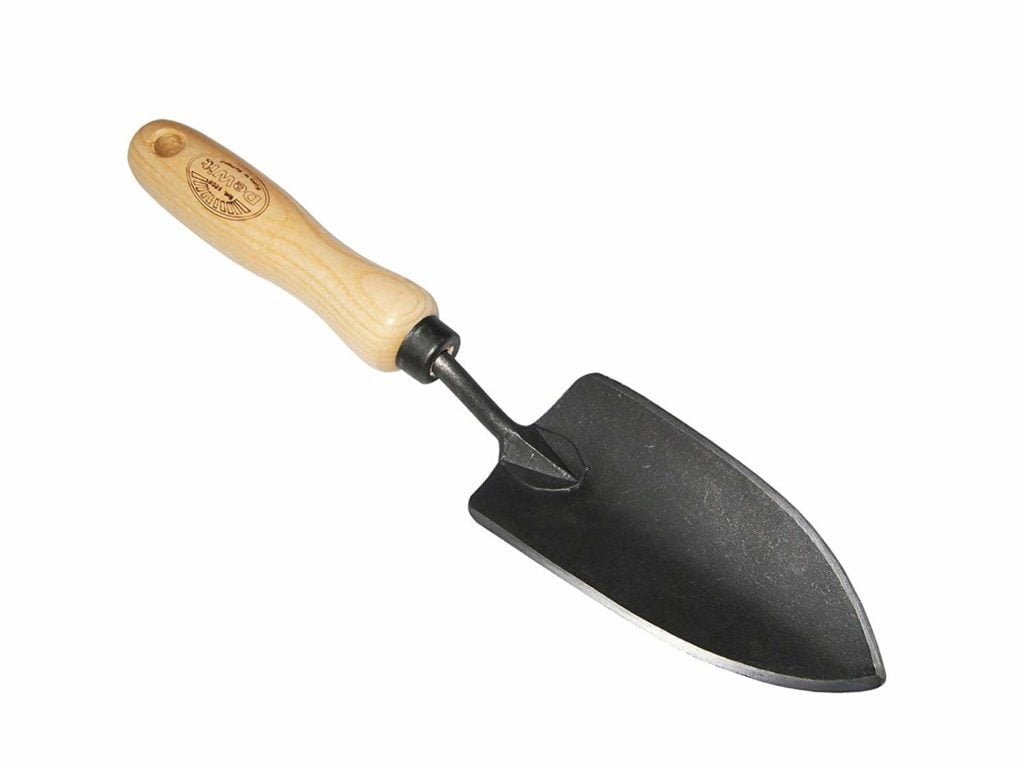
This DeWit trowel is smaller than others and great for smaller hands or for digging smaller holes. At 11.8 inches long and a 2.6-inch blade width, it’s much more compact than other instruments. The blade is made of boron steel.
One big advantage of this tool, besides its size, is that the edge of the blade is sharpened. This isn’t just at the tip; it goes all the way up the sides. This makes it easier to slice through soil as well as roots.
At only about 8 ounces, it won’t wear out your hand or arm, either.
At the same link above, you can click a button for their standard-sized trowel. There are also options for various types of handle.
Homegrown Garden Tools Garden Trowel
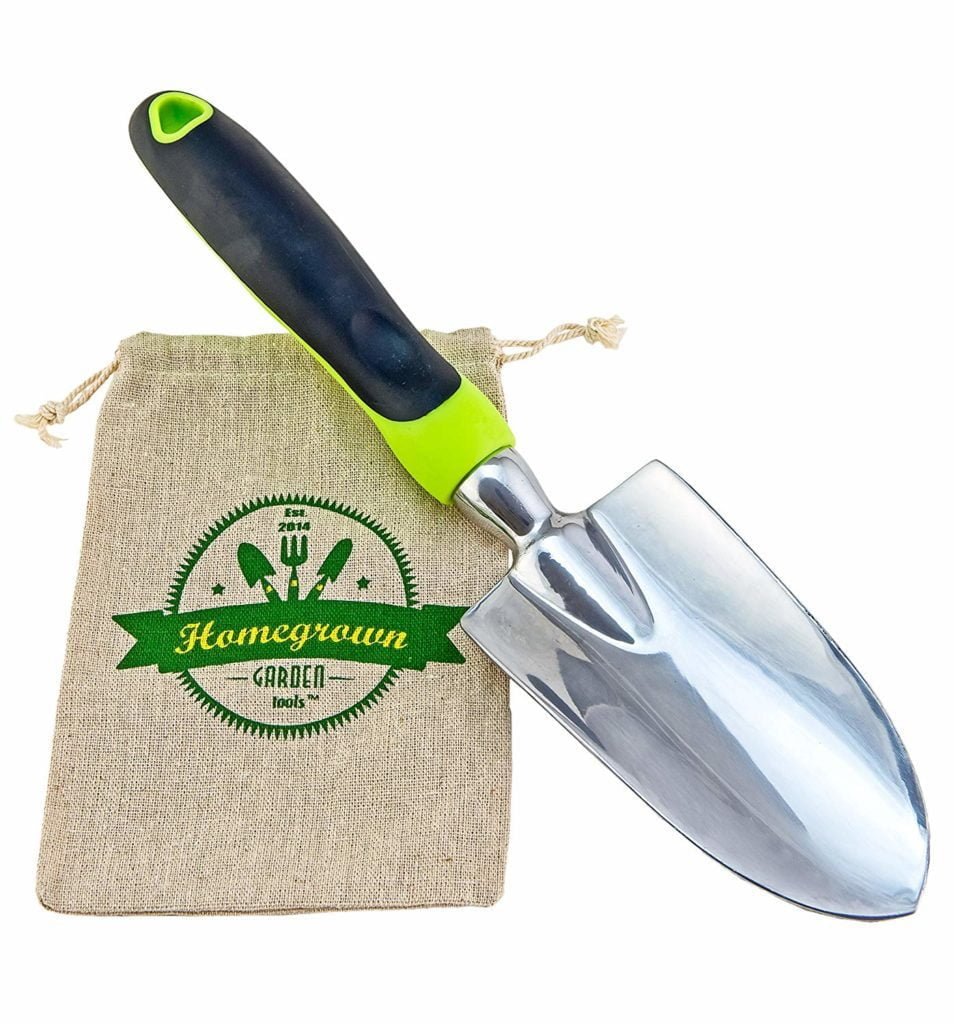
This cast aluminum-bladed trowel is the lightest on our list at just 7.4 ounces. It’s 12.5 inches long and the blade is about 3 inches across at its widest point.
The blade shaft extends about two-thirds of the way up inside the handle. While it’s not welded or bolted, it doesn’t seem subject to slipping out.
This is great for general-purpose digging in garden soil. It’s not sturdy enough for really hard soil or for trying to break up anything but the thinnest roots, though.
The rubber handle is relatively comfortable and contoured, making it easy to grip. It’s a bit larger than a generic tool, but not so large as to be uncomfortable if you have average-sized hands.
This trowel comes packed in a small burlap sack. It’s a cute packaging and branding device, and you may find other uses for the sack.
Conclusion
A garden trowel is one of the most basic tools you need for gardening, and it is one you’ll use often. That means it’s important to get a sturdy one that won’t tire out your hand and arm. Look for one with a comfortable grip that’s also sized appropriately for the work you usually do. You may need more than one if you frequently have to dig differently-sized holes!

